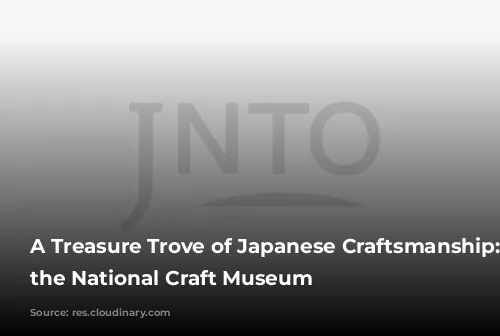Embark on a journey through the captivating world of Japanese craftsmanship at the National Craft Museum, nestled within the serene Kenrokuen Cultural Zone in Kanazawa. This museum, dedicated to preserving and showcasing the rich legacy of Japanese traditional crafts, offers a captivating glimpse into the artistry and skill that defines the nation’s cultural heritage.

A Journey Through Time and Technique
The museum’s collection boasts an impressive array of over 4,000 artifacts spanning a vast spectrum of artistic expressions. From delicate ceramics and shimmering glassware to intricate lacquerware, elegant woodcraft, woven textiles, and exquisite dolls, each piece narrates a story of tradition and innovation. The collection encompasses not only traditional crafts but also showcases contemporary design, encompassing industrial design and graphic design, reflecting the ever-evolving landscape of Japanese artistic expression.

A Window into the Past: The Museum’s History
The museum’s journey began in 1977, when it was initially established as the Craft Gallery of the National Museum of Modern Art, Tokyo. However, in 2020, it embarked on a new chapter, relocating to Kanazawa City, Ishikawa Prefecture, as part of the Japanese government’s administrative reform initiatives. As the only national art museum dedicated solely to crafts and design, the museum’s collection serves as an indispensable resource for research and understanding of Japanese art.

A Celebration of Traditional and Contemporary Art
The museum’s exhibits delve into the heart of Japanese craftsmanship, showcasing both timeless and contemporary works. The collection features a rich tapestry of artifacts, including woodcraft, bamboo, metalwork, glassware, ceramics, lacquerware, dolls, and textiles, offering a comprehensive overview of the diverse expressions of Japanese artistry. The collection also includes design pieces, encompassing graphic and industrial design, which demonstrate the enduring influence of tradition on modern design.
Preserving History and Showcasing Heritage
The museum’s building itself is a testament to historical preservation. The museum occupies two historic buildings: the former 9th Infantry Division Headquarters and the Army Veteran’s Club. These structures were meticulously dismantled and relocated from the Ishikawa Prefecture Noh Theater grounds to the Kenrokuen Cultural Zone. The buildings have been carefully restored to their original form, reinforced with concrete and connected by modern glass extensions, harmoniously blending the old and new.
An Interactive Journey of Discovery
Step into the museum’s first floor, and you’ll be greeted by the “Welcome to the World of Craftsmanship” exhibition. This interactive experience offers an immersive introduction to the art and techniques of Japanese craft. Visitors are guided through terminology and crafting methods, deepening their understanding and appreciation of the museum’s collection. The space also features a digital experience zone that allows visitors to explore select pieces from the collection in 360 degrees, bringing the artistry to life in a captivating way.
A Legacy of Mastery: The Matsuda Gonroku Studio
Ascend to the second floor, and you’ll encounter the Matsuda Gonroku Studio. This preserved workspace belonged to Matsuda Gonroku (1896-1986), a renowned artisan recognized as a Living National Treasure for his mastery of Maki-e, the traditional Japanese art of lacquerwork using gold and silver powder. The studio has been relocated to the museum and reassembled to reflect its original appearance during Gonroku’s lifetime. Visitors can examine the tools and materials Gonroku used to practice his craft, gaining insights into his creative process. Additionally, video documentaries shed light on Gonroku’s life and artistic journey, offering a glimpse into his legacy.
A Journey Through Time and Artistic Expression
The National Craft Museum stands as a beacon of Japanese cultural heritage, showcasing the nation’s enduring artistry and meticulous craftsmanship. From traditional techniques to contemporary design, the museum offers a captivating journey through time and artistic expression, highlighting the enduring legacy of Japanese craftsmanship. Whether you’re an art enthusiast or simply seeking a deeper understanding of Japan’s cultural heritage, the National Craft Museum promises an unforgettable exploration into the world of Japanese artistry.

